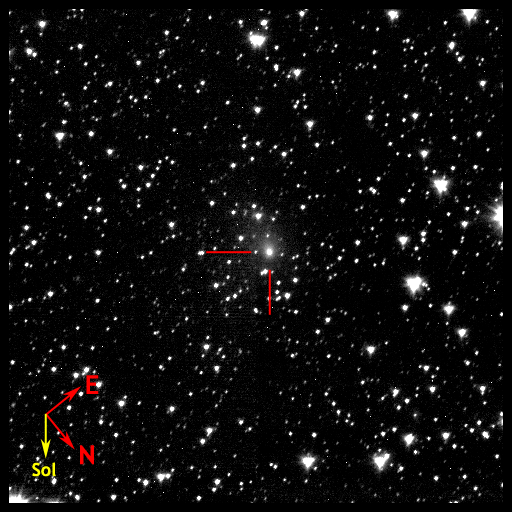EPOXI
Two intriguing investigations -- One flight-proven spacecraft
News: Tally-Ho! Deep Impact Spacecraft Eyes Comet Target, 2010.09.08
Press Release
Tally-Ho! Deep Impact Spacecraft Eyes Comet Target2010.09.08
 Click for larger image.
Click for larger image.
60 Days before its flyby, a NASA spacecraft takes a picture of its quarry - comet Hartley 2.
Credit: NASA/JPL-Caltech/UMD
On Sunday, Sept. 5, NASA's Deep Impact spacecraft beamed down the first of more than 64,000 images it's expected to take of Comet Hartley 2. The spacecraft, now on an extended mission known as EPOXI, has an appointment with the comet on Nov. 4, 2010.
It will use all three of the spacecraft's instruments (two telescopes with digital color cameras and an infrared spectrometer) to scrutinize Hartley 2 for more than two months.
"Like any tourist who can't wait to get to a destination, we have already begun taking pictures of our comet -- Hartley 2," said Tim Larson, the project manager for EPOXI from NASA's Jet Propulsion Laboratory in Pasadena, Calif. "We have to wait for Nov. 4 to get the close-up pictures of the cometary nucleus, but these approach images should keep the science team busy for quite some time as well."
The imaging campaign, along with data from all the instruments aboard Deep Impact, will afford the mission's science team the best extended view of a comet in history during its pass through the inner solar system. With the exception of one, six-day break to calibrate instruments and perform a trajectory correction maneuver, the spacecraft will continuously monitor Hartley 2's gas and dust output for the next 79 days.
This first image of comet Hartley 2 taken by Deep Impact was obtained by the spacecraft's Medium Resolution Imager on Sept. 5 when the spacecraft was 60 million kilometers (37.2 million miles) away from the comet.
EPOXI is an extended mission that utilizes the already "in flight" Deep Impact spacecraft to explore distinct celestial targets of opportunity. The name EPOXI itself is a combination of the names for the two extended mission components: the extrasolar planet observations, called Extrasolar Planet Observations and Characterization (EPOCh), and the flyby of comet Hartley 2, called the Deep Impact Extended Investigation (DIXI). The spacecraft will continue to be referred to as "Deep Impact."
NASA's Jet Propulsion Laboratory, Pasadena, Calif., manages the EPOXI mission for NASA's Science Mission Directorate, Washington. The University of Maryland, College Park, is home to the mission's principal investigator, Michael A'Hearn. Drake Deming of NASA's Goddard Space Flight Center, Greenbelt, Md., is the science lead for the mission's extrasolar planet observations. The spacecraft was built for NASA by Ball Aerospace & Technologies Corp., Boulder, Colo. For more information about EPOXI visit http://epoxi.astro.umd.edu/ .
DC Agle
Jet Propulsion Laboratory, Pasadena, Calif
818-393-9011
agle [at] jpl [dot] nasa [dot] gov
RELEASE: 2010-291, Source
